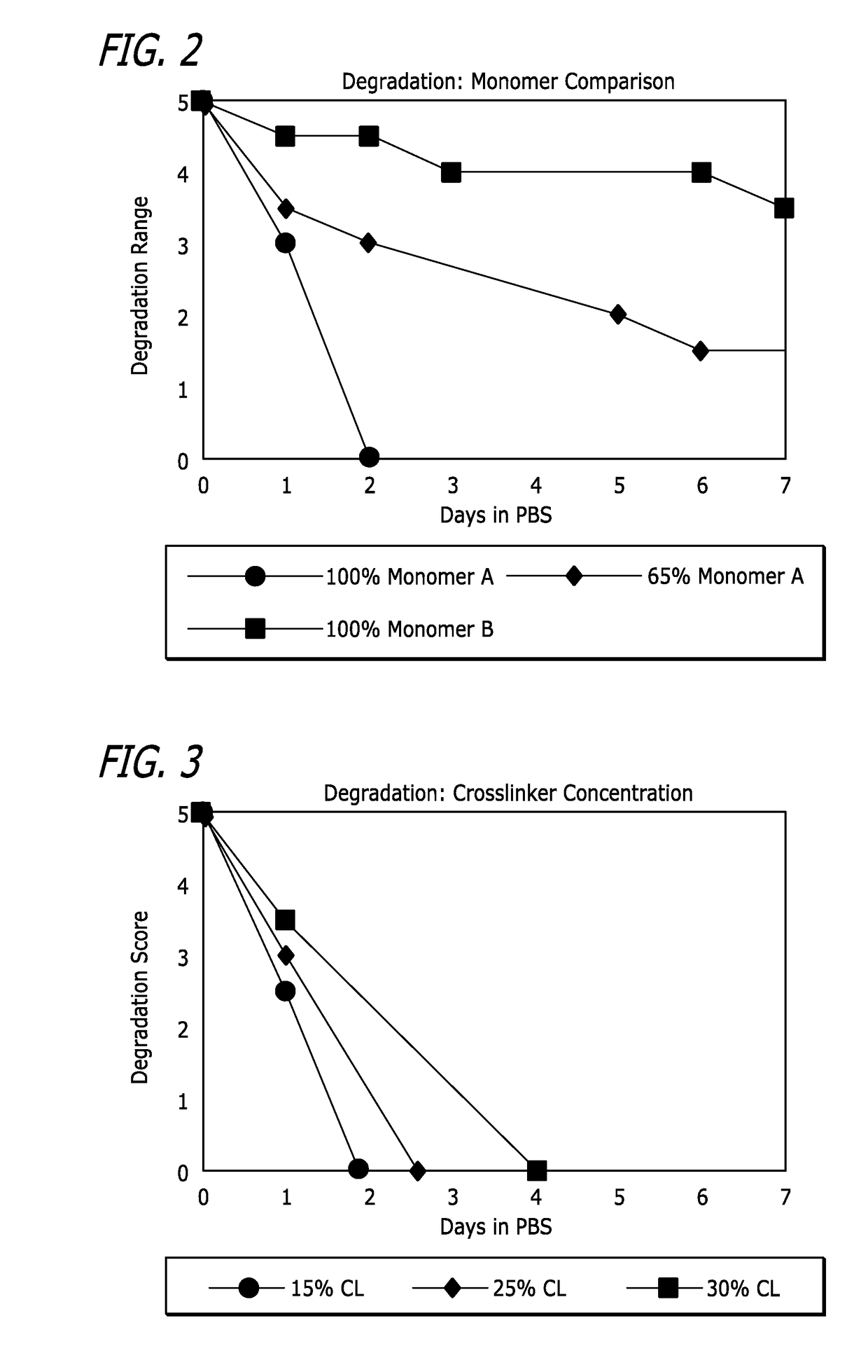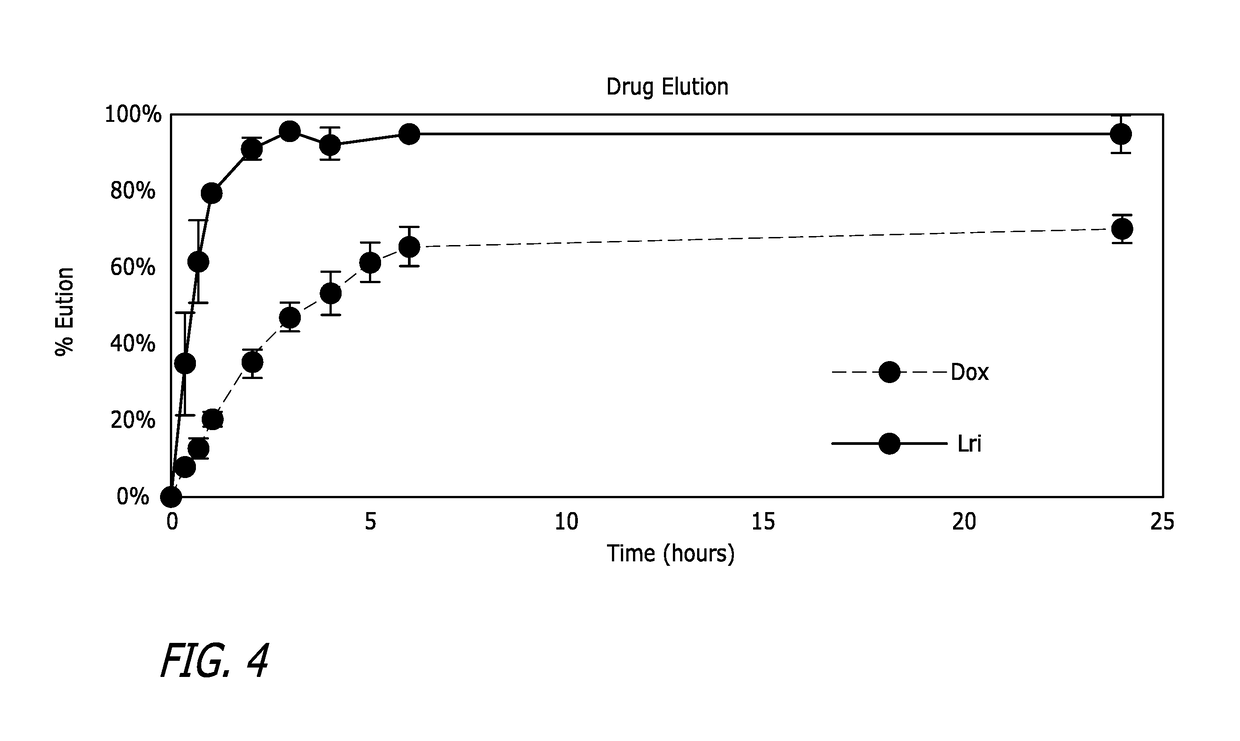Polymer particles
a technology of polymer particles and particles, applied in the field of polymer particles, can solve the problems of easy degradation of polymer particles, and achieve the effect of minimizing the biological effect of degradation products
- Summary
- Abstract
- Description
- Claims
- Application Information
AI Technical Summary
Benefits of technology
Problems solved by technology
Method used
Image
Examples
example 1
Biodegradable Crosslinker
[0072]
[0073]Synthesis of 2-(methacryloxy)ethyl oxalyl monochloride, 3: An oven-dried 100 mL three-neck round bottom flask was purged under argon. The flask was fitted with a stir bar and an addition funnel. To the flask was added oxalyl chloride (1, 20 g, 158 mmol) and anhydrous dichloromethane (DCM) (15 mL) sequentially. To the addition funnel was added 2-hydroxyethyl methacrylate (HEMA) (2, 16 g, 123 mmol). The flask was cooled in an ice bath and HEMA was added dropwise to the reaction. After the addition was finished, the reaction was left stirring in the ice bath for 1 hour. The flask was pulled out of the ice bath and stirring was continued for 1 hour. To work up, removed the DCM and oxalyl chloride on a rotary evaporator. Avoid moisture from here on. The product is a greenish liquid. It does not move on a silica TLC plate and has strong UV absorption.
[0074]Synthesis of 4: An oven-dried 50 mL three-neck round bottom flask was purged under argon. The, 2-...
example 2
Biodegradable Crosslinker
[0075]
[0076]Synthesis of 6-(methacryloylamino)hexanoic acid, 6: In a 50 mL round bottom flask, 6-aminohexanoic acid (5, 8.45 g, 64.6 mmol) and sodium hydroxide (2.6 g, 65 mmol) were dissolved in distilled water (13 mL). The flask was cooled in an ice bath. To this solution was added methacryloyl chloride (6.26 mL, 64 mmol) dropwise and then stirred for two hours. To work up, washed the reaction with DCM (12.5 mL). The aqueous fraction was kept and the pH of the aqueous layer was adjusted to 2.0 with 1 M hydrochloric acid. The aqueous layer was extracted with EtOAc (30 mL×3). The organic fraction was combined and dried over Na2SO4. The solvent was removed under reduced pressure. The crude product was crystallized with EtOAc and hexanes to give the product as clear crystals (4.65 g, 36.5%).
[0077]Synthesis of 6-[(2-methyl-1-oxo-2-propen-1-yl)amino]hexanoyl chloride, 7: A three-neck round bottom flask was purged under argon. Then, 6-(methacryloylamino)hexanoic a...
example 3
Biodegradable Crosslinker
[0081]
[0082]Synthesis of oxalate diester crosslinker, 15: To a 100 mL round bottom flask with a stir bar was added oxalic acid (13, 5.4 g, 60 mmol), 1-butyl-3-methylimidazolium bromide ([Bmim]Br) (18 g, 84 mmol) and 4-methoxyphenol (120 mg, 0.97 mmol). The content was melted at 90° C. with stirring for 15 minutes. After adding glycidyl methacrylate (14, 17.04 g, 120 mmol), the reaction was stirred at 90° C. for 1 hour. Thin layer chromatography stain with 4-(4-nitrobenzyl)pyridine showed full consumption of the epoxide. The reaction mixture was suspended in 200 mL of EtOAc and washed with water (100 mL×2), saturated sodium bicarbonate (100 mL×2), and brine (100 mL). The organic phase was collected and dried over sodium sulfate. The crude was dried under vacuum and purified with flash chromatography (DCM / EtOAc). Total of 12.7 g of purified product was obtained as a clear liquid.
PUM
| Property | Measurement | Unit |
|---|---|---|
| Time | aaaaa | aaaaa |
| Diameter | aaaaa | aaaaa |
| Diameter | aaaaa | aaaaa |
Abstract
Description
Claims
Application Information
 Login to View More
Login to View More - R&D
- Intellectual Property
- Life Sciences
- Materials
- Tech Scout
- Unparalleled Data Quality
- Higher Quality Content
- 60% Fewer Hallucinations
Browse by: Latest US Patents, China's latest patents, Technical Efficacy Thesaurus, Application Domain, Technology Topic, Popular Technical Reports.
© 2025 PatSnap. All rights reserved.Legal|Privacy policy|Modern Slavery Act Transparency Statement|Sitemap|About US| Contact US: help@patsnap.com



